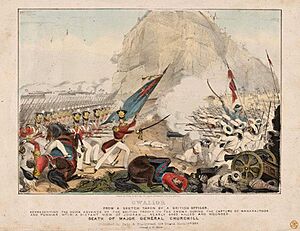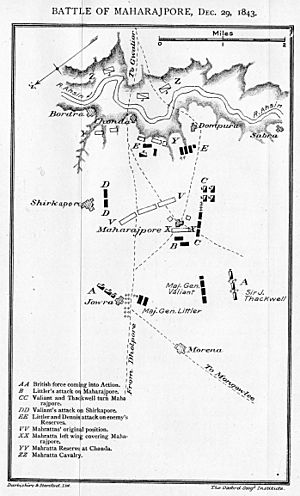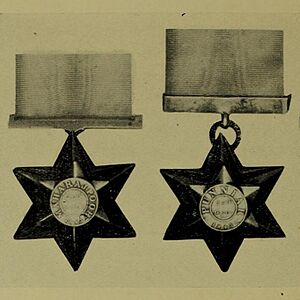Gwalior campaign facts for kids
The Gwalior Campaign was a series of battles in December 1843. It was fought in Gwalior, India. The battles were between the British and the Maratha forces. The British were represented by the East India Company.
Contents
Why the Gwalior Campaign Happened
For a long time, the Maratha Empire ruled a large part of central and northern India. But by 1818, the British had taken control. This gave the British power over almost all of India.
In Gwalior, the local ruler, called the Maharaja, had died. A young child was chosen to be the new Maharaja. The British supported this choice. However, many Maratha people in Gwalior wanted to be free from British rule.
They saw that the British had struggled in a war in Afghanistan. This made them think it was a good chance to become independent. So, they removed the young Maharaja from power.
The British leader, Lord Ellenborough, expected this. He had already gathered an army near Agra. This army was called the Army of Exercise.
The British tried to talk things out, but negotiations failed. So, the British army moved forward. They attacked from two different directions.
The British forces were led by General Sir Hugh Gough. They fought against the Maratha forces, led by Maharaja Scindia. Two major battles happened on the same day: 29 December 1843.
The Battle of Maharajpur
The Maratha army at Maharajpur was very strong. They had 14 groups of soldiers, 1,000 artillery gunners, and 60 cannons. They also had 6,000 cavalry (soldiers on horseback).
The British army was also well-organized.
- The center group included the 40th Regiment of Foot. It also had the 2nd and 16th Native Infantry Regiments.
- The left group had the 39th Regiment of Foot. It also included the 56th Native Infantry Regiment and some cannons.
- The right group had the 16th Lancers and other artillery.
The British center group moved forward. They thought the main Maratha army was in one spot. But during the night, the Marathas had moved their positions.
The British were surprised when they came under heavy fire. Maratha cannons fired many shots from their new spots. The British center group was ordered to capture these cannon positions.
They advanced under constant heavy fire. They faced different types of cannon shots. The Maratha cannons were south-east of Maharajpur. Each cannon battery had two groups of Maratha soldiers protecting it. Inside Maharajpur, there were seven groups of soldiers for each battery.
The British fought the Marathas in close, hand-to-hand combat. Both sides suffered many losses. The British managed to clear the Maratha positions. The Marathas fought bravely, and few escaped.
The British finally won the battle. They lost 797 men who were killed, wounded, or missing. The Marathas were thought to have lost between 3,000 and 4,000 men.
The Battle of Punniar
On the same day, 29 December 1843, another battle happened at Punniar. The Maratha forces at Punniar had about 12,000 men. They were positioned on high ground near a place called Mangore.
As the British army approached, they immediately attacked. The British quickly drove the Marathas from the hill.
What Happened After
After the Maratha forces were defeated in Gwalior, the British took action. They broke up the Maratha army. They also set up a British force in the state. The government of Gwalior had to pay for this new force.
A British governor was put in charge of Gwalior Fort. British soldiers who fought in the campaign received a special medal. This medal was called the Gwalior Star.




